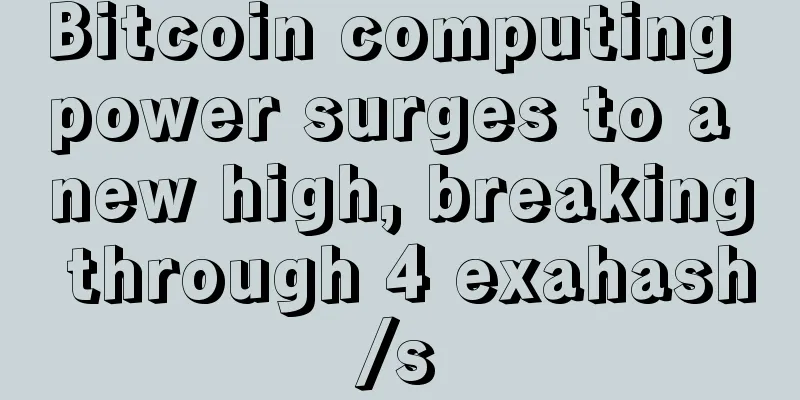Bitcoin computing power surges to a new high, breaking through 4 exahash/s

|
The ecosystem is booming as the decentralized network continues to break new records in 2017. The Bitcoin network hashrate has surpassed 4 exahash/s this month, setting a new record. Bitcoin computing power crosses 4 exahashThe Bitcoin mining environment is expanding massively as a large number of participants and mining pools compete to process transactions and earn new Bitcoins. The mining industry has now moved from home mining on personal computers to mining at giant data facilities (thousands of devices) spread all over the world. As early as one year and four months ago, Bitcoin computing power had entered the exahash level, reaching 1 exahash/s in January 2016. As of today, the collective computing power of miners has exceeded 4 exahash/s or 4,216,797,036 GH/s, surpassing the world's most powerful supercomputer. 1 exahash can solve 10^18 hashes (using algorithms to solve problems) per second, which means that the computing power of the Bitcoin network has exceeded exascale, reaching 4×10^18. According to research results, exascale computing technology will double in 2018, and the Bitcoin network has become one of them when it exceeded 1.5 exahash/s in mid-2016. The introduction of new mining chips and the growth of mining pools have made many people believe that Bitcoin is the most secure computing network ever. Mining revenue increased, network computing power increased, and the number of mining pools reached a new highOver the past year, the rise in the price of Bitcoin against fiat currencies has pushed the mining industry to new heights. According to data, the rise in mining revenue is now at an unprecedented level, and miners are accumulating coinbase rewards and mining fees. However, the network computing difficulty is also becoming so difficult that a single miner cannot make a profit without joining a mining pool. Bitcoin network difficulty is an indicator that measures the difficulty of miners finding a hash under a given target. Computing power distribution of large mining pools, data source: Blockchain.info, May 8, 2017 Mining pools have been around for a long time. A few years ago, some people thought that the hashrate distribution was too concentrated in a few pools. In particular, in the summer of 2014, the Ghash mining pool had more than 51% of the total network hashrate. However, in 2017, the number of mining pools has reached an unprecedented level, with about 22 mining pools controlling the majority of the hashrate. However, no mining pool has a hashrate share of more than 20%. Only 6 mining pools are significantly larger than the others. Bitcoin's increasing mining capacity ensures the strength of the Bitcoin blockchainLooking at Bitcoin's hashrate and comparing it to other altcoins that also use PoW, we can see that Bitcoin's processing power is several orders of magnitude higher. For example, Litecoin's network hashrate is 5,695 GH/s, Ethereum's is 23,766 GH/s, and Dash's is 1,252 GH/s. The Bitcoin network has far more processing power than all three of these altcoins combined. This makes the Bitcoin distributed ledger not only the largest, but also considered the most secure blockchain on the planet. |
>>: New retirement option | Ethereum personal retirement fund
Recommend
Major websites that accept Bitcoin as a payment method
Long gone are the days when Bitcoin was considere...
Who will go beyond the bottom line for love?
Recently, the trial of a pregnant woman in Heilon...
What kind of woman is suitable to be a wife?
What kind of woman is suitable to be a wife? ====...
Ten moles on your face to tell you about your love life
Maybe we don’t know that the moles on our faces c...
How to tell a woman's personality from her eyebrows
In physiognomy , eyebrows can not only reveal a p...
Everyone should know that women with these facial features have difficulty in giving birth
Childbirth is very important for a woman. Being a...
What should I look at to solve the problem of horizontal lines on the root of a man's nose?
In real life, people with different facial featur...
Big Pie fluctuates, market differentiation intensifies
Author | Hashipi Analysis Team...
How to understand a person's personality through forehead physiognomy
People with round foreheads If a person has a rel...
Eyes can tell wealth and fortune
Eyes can tell wealth and fortune The eyes and the...
Swift reveals luxury blockchain project: 100 banks involved, plans to replace existing cross-border settlement system
Swift, a global financial communications service ...
How you walk reveals your personality and fortune
How you walk reveals your personality and fortune...
Eyebrows and face reading diagram for men
Man with distinct eyebrows If a man has distinct ...
What kind of women make men salivate
What kind of women make men salivate The curved e...
UBS Asia Pacific CTO calls for the establishment of blockchain industry standards
Peter Stephens, CTO of UBS Asia Pacific, recently...









